|
|
 |
 |
| The Exterior Facade and Interior Surfaces |
|
|
The images on the exterior of a temple must be understood in relation to the temple as an architectural whole, and in relation to the religious ideology that defines the temple. The object within the central chamber (the garbha-griha, or "womb chamber") is no less defined by its own space. The importance of the garbha-griha as the location of the central living image of the temple's focal deity is demonstrated by its placement and the organization of movement and activity around it. The worshiper enters the sacred space and is drawn to its center and into the presence of the deity housed within. All of the images in and on a temple are integrated into a single unifying vision that is expressed throughout the structure; the glorious diversity and replication of these images are meant to be read as a single statement.
Most of a Hindu temple's ornamentation is on its external surface, which was originally brick (Figure 1), and later usually stone. In general, the sculpted surface is created as the temple is being built: slabs of stone are put in place, and then the sculptors carve the figures into the stone in situ. The external walls of a temple are adorned with images according to a fairly fixed system that nevertheless allows great individual and regional diversity. Originally, temple walls had a central recess, or raised area, containing one large image, often dominated by a single frontal figure (Figure 2); this type of relief can be seen in its original context at Deogarh in modern-day Uttar Pradesh (Figure 3). Later, these images were accompanied by subsidiary images that occupied the corners and intermediary recesses of shrines (Figure 4). The middle image generally represented some aspect of the divinity contained within the garbha-griha, or displayed related deities or forms (avatara) of the God. An image like that of Ganesha (Figure 3) might occupy such a central location on the exterior wall of a shrine, while subsidiary images might have consisted of directional guardians and, later, female attendants (Figure 4). Recessions or indentations might also be adorned with mythical beasts or sages (Figure 5).
External walls of shrines, halls, and platforms came to be increasingly ornate as Hindu temple architecture developed further in the beginning of the second millennium (Figure 6). In consequence, the temple complex might contain many additional subsidiary images worshiped by the devotee in the same way as the central images of the temple sanctuary. These additional figures could be experienced in relation to the central temple and its key images in the worshiper's circumambulation of the central shrine. Natural icons may also be found near a temple, to honor the central deity. A basil (tulsi) plant, sacred to the great God Vishnu, for example, is frequently found near temples dedicated to him.
A tower over the central shrine, covered in vertical bands or small spire shapes, is a distinctive feature of the Hindu temple in both its northern (nagara) and southern (dravida) forms. The interiors of the temples of medieval India are also highly ornate, with intricately carved ceilings and architectural elements. One such element is a bracket attached to a temple pillar, designed to support the ceiling or wall (Figure 7).
< previous next >
Top |
|
 |
 |
| Click for details |
 |
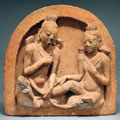 |
 |
Fig. 1
|
 |
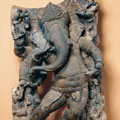 |
 |
Fig. 2
|
 |
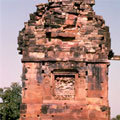 |
 |
Fig. 3
|
 |
 |
 |
Fig. 4
|
 |
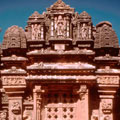 |
 |
Fig. 5
|
 |
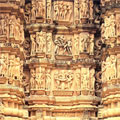 |
 |
Fig. 6
|
 |
 |
 |
Fig. 7
|
 |
|
 |


